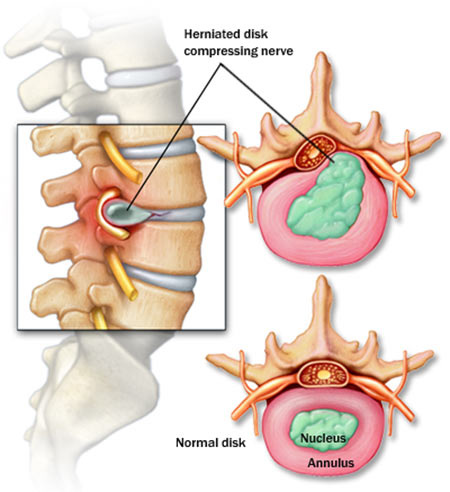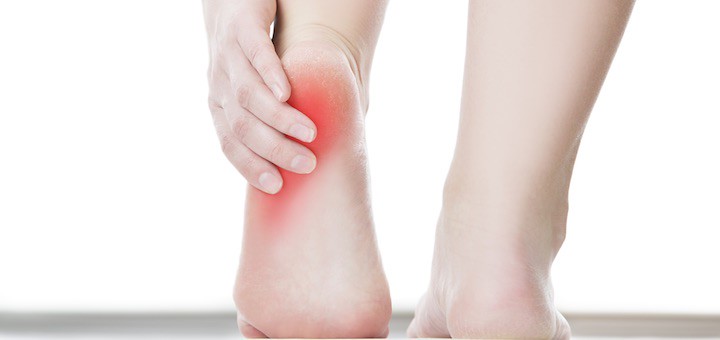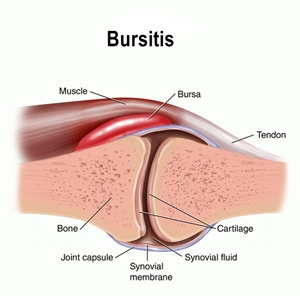Monthly Archives: July 2018
Herniated disk
Posted on July 27, 2018 by admin
The spine consists of spinal disks and vertebrae and similar to a jelly donut, the disk has a softer “jelly” center. When the “jelly” pushes out through a tear in the tougher exterior, it is known as a herniated disk. Disk degeneration can cause disk herniation in the lower back or in the neck. The water content in the disks decrease as we get older and the flexibility of it decreases. Therefore, a minor strain, twist, and improper lifting can easily lead to a tear or rupture in the disk.

The signs and symptoms that someone will experience includes pain, numbness, tingling, or muscle weakness due to the irritation on the nerves. Pain can be felt in the thigh and calf when the herniated disk is in the lower back. Pain can be felt in the shoulder and arm when the herniated disk is in the neck.
Excess body weight and duties performed on the job that put extra stress on your lower back can increase the risk of disk herniation. A few things that you can do to prevent a herniated disk includes lifting heavy objects properly, strengthening trunk muscles, and maintaining a healthy weight.
Heel Spurs
Posted on July 18, 2018 by admin
Heel spurs are also known as calcaneal spurs or osteophytes. Someone with this condition would find a calcium deposit forming a bony protrusion along the plantar fascia. Running and jumping, especially on hard surfaces can wear down the heel and lead to heel spurs. If the membrane that covers the heel bone is torn or if the heel is bruised, it can cause heel spurs. Older adults, obesity, plantar fasciitis, and improper footwear can increase the chance of developing heel spurs.

Heel spurs can lead to a sharp pain in the heel when he or she stands up, a dull ache in the heel, and heat radiating from the affected area. Tenderness, swelling, and inflammation can occur at the heel and a bone-like protrusion beneath the heel may also be seen. One can reduce pain and swelling by resting and applying ice to the affected area. Orthotics can also be worn to remove some of the pressure off the heel.
Myositis Ossificans
Posted on July 11, 2018 by admin
Myositis ossificans is when bone tissue forms within a muscle. It is usually found in the thigh muscles where the hamstring and quadricep muscles are found. Myositis ossificans can develop when a contusion (bruise), repetitive trauma, or strain occurs to a muscle. Calcification and bony formation can occur in the injured muscle when a repetitive trauma occurs before the injured area has been completely recovered. Therefore, it is important to rest the muscle after an injury. To prevent a repetitive trauma from happening, one can use protective padding and perform stretches to avoid muscle strain. Intensive stretching and massage should be avoided because it inhibits healing and increases bleeding into the muscle. Myositis ossificans can also occur if the inflammation and swelling of the muscle is ignored after an injury.
Moreover, myositis ossificans can lead to swelling, pain when exercising, limited range of motion, a weaker limb, and a hard bump. However, it can be treated by resting the muscle, strengthening the injured muscle and the muscles around it, and working on flexibility and light stretching. In addition, ultrasound can also help with the healing process.
Bursitis
Posted on July 4, 2018 by admin
Bursae are small, fluid-filled sacs that act as a cushion for the bones, tendons, and muscles around the joints. When they become inflamed, it is known as bursitis. Bursitis can occur in the shoulder, hip, elbow, and knee. Repetitive movements or positions that can apply pressure on the bursae, such as lifting something over your head repeatedly or kneeling on your knees for a long time can lead to bursitis. Inflammatory arthritis, an injury or a trauma can also cause bursitis. Someone who has bursitis will notice their joint becoming red and swollen. In addition, the joint will feel achy or stiff and they will feel pain when they try moving the joint or when they apply pressure to it.

Older adults, overweight individuals, and individuals with rheumatoid arthritis have a higher risk of developing bursitis. However, one can reduce their risk by warming up and stretching before exercising, strengthening their muscles, lifting properly, carrying lighter loads, and taking breaks after performing repetitive movements. Rest, ice, and exercises can help relieve the pain. A corticosteroid drug can be injected into the bursa to reduce pain and inflammation. The pain will disappear within a few weeks if it is treated properly.